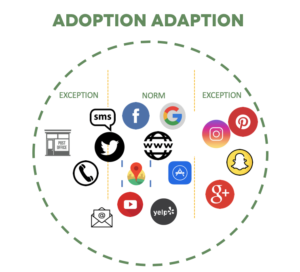YOUR DIGITAL STRATEGY 2
Digital channels and their consumption by your audience move and shift with trends and generations. Organizations, ministries included, have positioned themselves digitally depending on their message and product – choosing the best digital channel that would get them the best sales. But if we are going to take our mission and vision to the audience God has laid on our heart in a way that makes people feel “genuinely loved” (Romans 12:9), we have to sacrifice our mediocre or “as it happens” strategy.
Understanding what you are strategizing for helps! To that end a quick understanding of the digital landscape helps. These days, people are adopting preferred channels in order to communicate and express themselves. A home loving person who loves to decorate would prefer Pinterest whereas someone seeking a divorce attorney turns to Google search. A test taking high school student loves communicating on Snap Chat but is blown away when a potential college celebrates his birthday by sending him a card in the post. Gone are the days where the only way you could communicate with an organization would through the channels dictated to you by that organization. I recently changed banks when a service support technician insisted that I send a fax and not a scanned document from my iPhone.
If we are to genuinely love people and not just say that we love them, then we need to be able to build a strategy that adapts to what our audience adopts. We call it adoption adaption. But being present on all channels all the time is costly and time consuming. As a result, the first step in establishing a strategy that can adapt as channels change would be to ascertain the “norm” in your audience’s adoption range. One church represented it as follows:
 The old school platforms on the left of the adoption range are as much exceptions to your audience norm as the digitally advanced exceptions to the right. The norm however is ever shifting to the right with more platforms being created and adopted.
The old school platforms on the left of the adoption range are as much exceptions to your audience norm as the digitally advanced exceptions to the right. The norm however is ever shifting to the right with more platforms being created and adopted.
What platforms you invest in today as a norm, will be the outgoing exceptions within 5 years. If we are to be working with wisdom and insight, then we would be keeping a close eye on the immerging exceptions in your organization. (These are usually the platforms the youth in a church are using).
It is no longer acceptable for a leader to refuse to embrace digital channels simply because they “don’t do digital.” That’s not “leading with diligence” (Romans 12:8). You might not know the intricacies of how amplification works but you embrace the microphone when you stand to speak at an event. You may very well have a sound engineer but at the very least you have sufficient understanding on how to use the microphone to reach your audience. Digital Ministry is your new microphone!
Your strategy needs to be able to move as your audience adopts. It does not need to move as the world adopts, it needs to move as your audience adopts. This means that you are not doing your strategy justice by doing some general social media reading on google or even worse, assuming where your audience lies on the adoption spectrum based on your personal norm or preference. Breaking news: not everyone still uses a leather-bound bible in church and not everyone on their phone during your message are updating FB profiles…
I am not promoting ignoring the exceptions, left or right. A ministry needs to love the whole audience – focusing on the norm and catering for the exceptions.
Sometimes when looking at your current and potential audiences you will have to make resource decisions and will not be able to cater for the norm. For example, you may not have the resources to print and post annual giving statements even though you have partners who love their letters. You will need to functionally engage on a cost-effective channel. Make sure though that when you dictate a communication channel it is for functional reasons. Wherever possible try and relationally engage on the platforms your audience are adopting.
Ministries generally fall into a few traps:
- Over-exaggeration of the exceptions
- Under-exaggeration of the exceptions
- Assumption of the norm
- Over adoption of channels and platforms
- Knee jerk reactions to demands made by the exception audience
You have to start by getting a grip on who your audience is going to be or who is going to be most affected by your movement. Studying demographics and adapting accordingly is what we do every time we stand in front of an audience to speak and so should we be doing when we begin embracing Digital Ministry.
In part 2 of this subject we will take a closer look at our audiences and our movement and what it means to create a strategy that closes the loop for your audience.
0 Comments